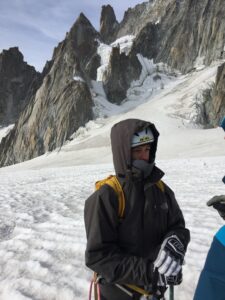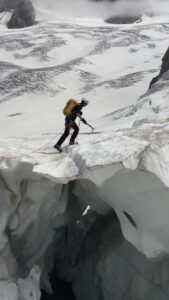Objective Everest: Dylan ZEPI aims to reach the roof of the world!
Dylan ZEPI, 20, is a second-year student in the Grande École program at IÉSEG. He has set a goal for himself unlike any other. He is preparing to climb the highest summit in the world in 2024: Mount Everest, at an altitude of 8,849 meters. We met with him to find out who and what is behind this extraordinary project.

Dylan ZEPI
Why did you set yourself such a challenge?
The desire to challenge myself, without a doubt, is what drives me to prepare for climbing Mount Everest. This idea came to my mind 4 years ago, and after I ran my first half-marathon, everything followed. I climbed Machu Picchu and Huayna Picchu in Peru, and Pico Turquino in Cuba. Then, I did my first preparatoy walks to climb the Mont Blanc. I like to take on crazy challenges. For example, I went backpacking around Europe alone, on a whim. Then, I concentrated on my studies to pass my Baccalauréat and enter IÉSEG… until the desire came back even stronger than before! So, I started training intensively again in December 2022. And if I succeed in reaching the summit in 2024, as I expect, I will become one of the very few under 21 years old who made it. As far as I remember, I have always liked to go beyond my limits, to go further and further, especially in sports, and I obviously love the mountains!
I think it’s important to set goals for yourself, and that’s why I’m aiming for 2024 for this climb, provided, of course, that I manage to raise the necessary funds and sponsors as planned.
How are you going to prepare concretely?
Since December, I’ve been focusing on physical preparation. This includes muscle strengthening, cardio, sessions of overcoming my limits by running the extra mile at each training session, until I reach my true limit. The goal is to go always further. This is mixed with mental preparation, which consists of pushing the limits of the mind, because once up there, everything is about the mind. So I need to find out how far my mind can take me. Then, this summer, I’m going to Chamonix to hike to the Mont Blanc and the Mont Rose (the 4th highest peak in the Alps) and follow up with the GR20 (one the best-known and most difficult hiking trail in Corsica).
In the first semester of the academic year 2023-2024, I will do my exchange in Kazakhstan. I will seize this opportunity to climb the Lenin Peak (a 7,134m high summit in Tadjikistan). The winter will then allow me to test my snow equipment (crampons, ice axe…) by doing various hikes. The idea is to become as familiar as possible with my equipment so that it becomes second nature. Indeed, when you are at a certain altitude, the slightest movement requires a real effort, so it is necessary to know perfectly your equipment and to know where to find which object to use in order not to lose energy unnecessarily and to preserve yourself as much as possible. I will perhaps add to this some tests in hypoxia in order to train myself to support the lack of oxygen.
I will also look up what mountains I could climb between January and March, knowing that this period is quite limiting for high mountain climbs, for safety reasons. Finally, the idea is to go to Nepal in March, for a total period of two months.
Why do you plan two months in Nepal?
You need to have time to get acclimatized to the altitude and the climate there, and to do some hiking to train before the climb. The acclimatization process takes one month on average. It is also necessary to foresee the potential waiting time for the appropriate weather to be able to climb. AMS (acute mountain sickness) can also occur during the ascent (dizziness, headaches, nausea, fatigue…) and this, in a totally unpredictable way. You can be affected by acute mountain sickness one day, and not be affected the next day. The only way to counteract it is to go back down. So there are a lot of factors that can determine the success of this climb, beyond the physical preparation. It is well known that this is not the most difficult mountain to climb technically speaking, but it is the most difficult because it is the most enduring and because it plays a lot with our mind ad our mood.

Dylan ZEPI
How does it work to climb Everest?
You have to hire a specialized agency: of course, you cannot go alone. I put safety first and so I look for the best agency with the budget that I will manage to gather. To choose it, I contacted people who already made the climb, to collect their opinion and their advice. On the other hand, this project is extremely expensive, and that’s why I’m looking for sponsors who can help me reach my goal.
Do you have any fears about this climb?
I am aware of the danger that it represents. Every year, there are several deaths on the way to Mount Everest, not to mention possible frostbite leading to amputations. However, I am not really worried: I am very eager to go. My main fear is that I won’t find the sponsors I need to undertake this project, or that I won’t make it to the summit. Mental preparation is not only about learning to push your limits, it’s also about learning to deal with the frustration if you can’t go all the way up. People who lose their lives are often people who put themselves in extreme danger because they were not mentally ready to give up so close to the end. It is therefore necessary to have the necessary mental preparation to know how to make the decision to stop and come back down if there is an absolute danger.
What do your family and friends think of this project?
They support me and help me to find sponsors and to get in touch with professionals. Of course, they are also afraid but they support me above all, and that is very important to me.
Can we draw a parallel between successfully climbing Everest and successfully studying at IÉSEG?
In some way, yes! In both cases, it requires rigor, discipline, willpower, sacrifices… but in both cases, the joy of success is immense! Preparing for such an ascension will certainly bring me a lot for the pursuit of my studies.




